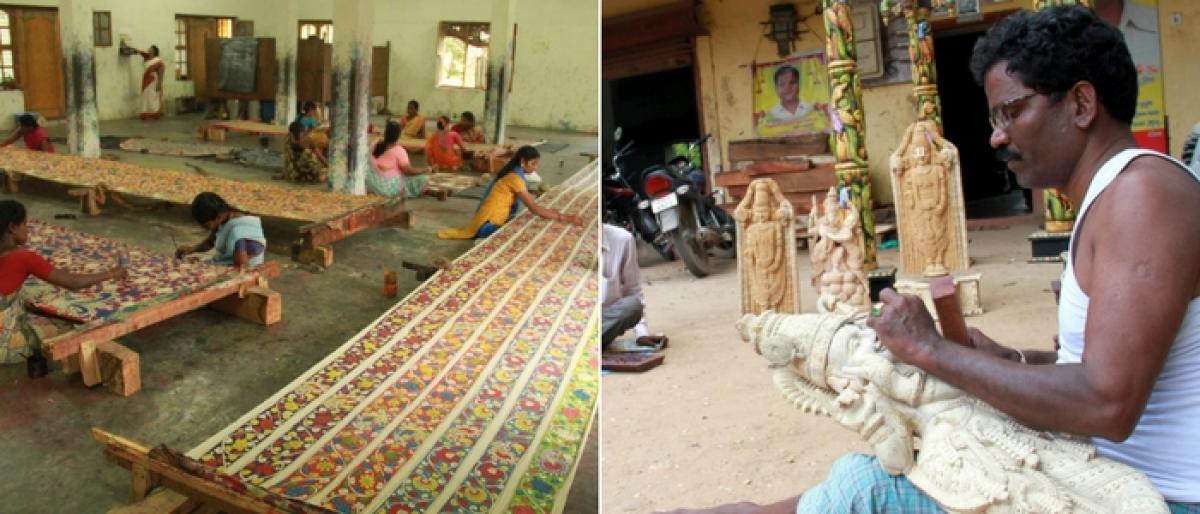Live
- PM Modi greets Minister Pralhad Joshi on his birthday
- Tirupati: Take up repairs of damaged roads, officials told
- Pawan Kalyan meets Vice President Jagdeep Dhankar, Continues Delhi Visit
- Heavy rain alert for Tirupati district due to low pressure
- EPACK Prefab constructs India’s fastest-built structure in 150 hrs
- Woman and her kids die under suspicious circumstances
- BMTC to increase bus running time on each route to drivers and conductors
- PDS implementation in Nalgonda sets a benchmark
- Ph D awarded
- BJP stands strong against Waqf Board misuse
Just In

Sri Kalahasti is gaining international reputation with its handicrafts of Kalamkari and woodcarving. The art is a visual feast and the artisans have won accolades nationwide for their artwork.
Sri Kalahasti Handicrafts are intricate and beautiful; however, with artisans seeking other jobs, as they cannot cope with the rising cost of raw materials, the art seems to fade away slowly…
Sri Kalahasti is gaining international reputation with its handicrafts of Kalamkari and woodcarving. The art is a visual feast and the artisans have won accolades nationwide for their artwork.
Sri Kalahasti woodcarvings are known for their beauty and quality. Even today, for any exhibition or show the Government sends its first invitation to the artisans here.
There are many classic pieces carved by the artisans like Vaikunta Dwaram, Sri Krishna Tulabharam, Gali Gopuram, Radha Krishna in the cradle, Vinayaka in different shapes among others. Not only mythological characters, they give life to many household articles like flower pots, doors, arches, etc. The artists have also worked on the Hindu temples, which were built abroad by the NRI’s.
The prices of their products depend on the size and the quality of the wood. It also depends on the number of man hours it takes to produce a particular product and they normally range between Rs.150 to Rs.10 lakh.
Artisans use different types of woods like mango, neem, local teak, Burma teak, rosewood, red, and white sanders, and jackfruit wood. Of them, the products made from red sanders are much in demand.
One cannot leave the place without buying something or the other after seeing the attractive designs of Kalamkari artwork, which are made on a soft cloth. Sarees, dress materials, lungis and even handkerchiefs are made with Kalamkari designs. Families, who indulge in woodcarvings also design Kalamkari artworks.
Initially, they used to design scenes from epics like Mahabharatha and Ramayana, however, they started losing the market as people did not appreciate the repeat designs. And from 2002 , artisans adopted modern designs and regained the market.
Despite the many technological innovations the artisans still carve wood with chisel, mallet, brushes, etc, to keep the authenticity of the craft and not to compromise on the quality.
And for such talent, awards are not a surprise. G Satyanarayana and brothers, who are the pioneers of this art at Sri Kalahasti have bagged National Awards.
G Satyanarayana, who passed away almost a year ago, has won National Award in 1994 for his work ‘Radha Krishna in the Cradle’. G Balakrishna won the same in 1995 for ‘Vaikunta Dwaram’ whereas G Balaji bagged the award for his work ‘Sri Kalahasti Temple Gali Gopuram’ in 1996.
All these were carved on Burma teak. Similarly, EP Satyam, Sekarachari also won National Awards, while Ravi Achari, Bhaskarachari and Rangachari have secured State awards.
But, of late, the artisans are seeking Government’s cooperation to keep the art form alive. Now the State Handloom Development Corporation (Lepakshi) is not purchasing the products from these artisans and they cannot market them on their own. Procuring the raw material is another major problem for the artisans. The neighbouring State Karnataka is supplying the raw material to the artisans in a rationing method.
Speaking to The Hans, former director of AP State Handloom Development Corporation G Dasarathachari said that they are requesting the Government to supply red sanders to them at a subsidised rate. Also, the Government should ensure that Lepakshi should purchase their products.
“As of now, we are not getting a reasonable price for our work. This is forcing the artisans to seek other works. And there is no one to encourage them if this continues the art will die slowly,” he said.
“The average turnover for Kalamkari items would be around Rs 1.5 crore per month. Each worker should be paid Rs 10,000.
As the raw material costs are abnormally increasing and it is becoming difficult to make both ends meet. The government should upgrade the latest designs from time to time and allot shops in famous temples for artisans,” he concluded.

© 2024 Hyderabad Media House Limited/The Hans India. All rights reserved. Powered by hocalwire.com







